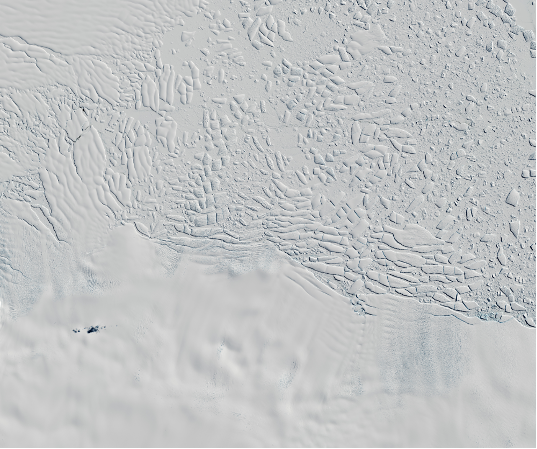Hidden from view by ice kilometres thick, there is a vast network of lakes and streams under the Antarctic ice sheet. Using a decade of altimetry data from European Space Agency’s (ESA) CryoSat satellite, researchers at the University of Edinburgh, including a scientist with the PROPHET project of the International Thwaites Glacier Collaboration (ITGC), have made an unexpected discovery about how lakes beneath Thwaites Glacier drain and recharge in quick succession.
Meltwater beneath the ice arises from frictional heating as the ice flows over the bedrock, as well as from geothermal heat coming from below the bedrock. Measurements of geothermal heat flux beneath the ice are particularly difficult to obtain and there are large differences between the various recent estimates. It is important that our knowledge of the distribution of meltwater and the geothermal heat flux is improved because both factors influence the speed the ice flows into the ocean.
While subglacial meltwater is hidden from view by kilometres-thick ice, its movement beneath the ice causes tiny movements on the surface of the ice, which, remarkably, can be detected and monitored from space.
A study published in the journal Geophysical Research Letters in December 2020 describes how a decade of radar altimetry observations have revealed a network of four subglacial lakes under Thwaites Glacier, which drained and recharged in two events observed within that time period. By comparing the rates to modelled estimates, the team found that previous models underestimated the rate of basal melting by 150%. This finding will help glaciologists reassess models and improve predictions of how the ice sheet might behave in the future.
At around 120 km wide, Thwaites Glacier is one of the largest glaciers on Earth and one of the most fragile in Antarctica. It is the focus of much international research through the International Thwaites Glacier Collaboration (ITGC), funded jointly by the UK National Environment Research Council (NERC) and US National Science Foundation (NSF), and ESA’s 4D Antarctica project.
ESA’s Diego Fernandez, head of the Earth Observation Science Section and overseeing the 4D Antarctica project, said, “The project draws together several years of research from different teams to form a new comprehensive assessment of Antarctic ice-sheet hydrological processes – from the lithosphere and subglacial environment to surface-melting process.”
Experts analyzed more than 10 years’ worth of altimetry data from ESA’s CryoSat satellite and were surprised to discover that the lakes beneath Thwaites Glacier, the largest of which is over 40 km long, drained and recharged again in quick succession, in 2013 and then in 2017.
This kind of drainage under Thwaites Glacier has not previously been recorded. The peak drainage was estimated at about 500 cubic metres a second – around eight times greater than the average discharge of River Thames in England into the North Sea.
George Malczyk, lead author at the School of GeoSciences at the University of Edinburgh in the UK, said, “We used CryoSat to show a period of lake activity only four years after the previous drainage event in 2013.
“But what is interesting about this second drainage event is how different it is from the first, with a faster transfer of water and increased water discharge. Our observations highlight that there were potentially significant modifications to the subglacial system between these two events.”
The relatively short time it took to recharge the lakes between the two drainage events gives scientists an unprecedented estimate of the rate of melting at the base of the glacier. Linking these observations with basal meltwater flowing into the lake through a network of basal channels resulted in an estimate of the rate of melting at the base of the ice sheet. By comparing these rates to modelled estimates, the team found that previous models underestimated basal melting under this region of Thwaites Glacier by nearly 150%. These findings will help to assess and constrain models and will, in turn, improve our understanding of the ice sheet, and the future of Thwaites Glacier.
Co-author Dr Noel Gourmelen, Reader from the University of Edinburgh and a researcher with the International Thwaites Glacier Collaboration's PROPHET project, said, “What takes place under the ice sheet is critical to how it responds to changes in the atmosphere and ocean around Antarctica, and yet it is hidden from view by kilometres of ice which makes it very difficult to observe.
“This movement of water gives us a glimpse of where the water is and how much and how fast it moves across the system. Together this is key information about the nature of the subglacial environment and the processes of the hydrological network under the ice sheet. These findings provide key information that may help us project how the ice sheet adds to sea level as it responds to climate change."
The paper, published in Geophysical Research Letters, was funded by the European Space Agency’s project 4DAntarctica, and by the PROPHET project, a component of the International Thwaites Glacier Collaboration (ITGC) supported by the US National Science Foundation and the UK Natural Environment Research Council.







